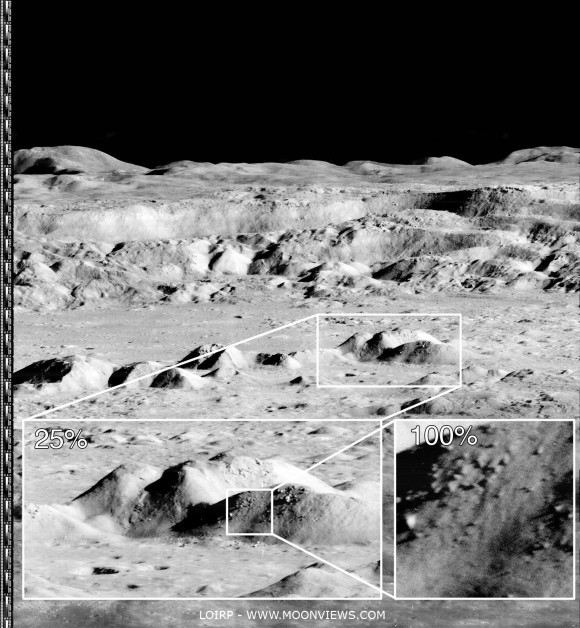 |
| Young impact craters often present a striking array of tones in their ejecta. Illumination is from the southeast, image is ~500 m across, LROC Narrow Angle Camera (NAC) observation M156964572L, LRO orbit 8266, April 9, 2011; resolution 0.55 meter over an incidence angle of 29.68° from 53.1 kilometers. View the larger LROC Featured Image HERE [NASA/GSFC/Arizona State University]. |
James Ashley
LROC News System
Yesterday's Featured Image post focused on regolith of contrasting reflectivity within the ejecta blanket of a 3 kilometer in diameter lunar impact crater.
Today's post shows another example of recently disturbed lunar regolith, but associated with a crater only 80 meters in diameter.
Impacts from space debris occur randomly across the lunar surface, and the target for this event just happened to be a fault slump along the high western wall of Lomonosov crater in the farside highlands.
Once again we see space-weathered, low-albedo deposits mixing with fresher ("optically immature") materials of higher albedo excavated from beneath the surface layer.
Because of space weathering the Moon is actually a relatively dark object in the solar system. Its overall low reflectance is not apparent to the human eye when seeing the Moon from Earth at night because the Moon is in direct sunlight against the inky black background of Space. In spacecraft images showing the Earth-Moon system (properly exposed as a pair) the low albedo of the Moon becomes obvious.
Lomonosov may be a highland crater, but its floor more closely resembles a mare deposit, being composed of a smooth lava plain. Compare Lomonosov with Plato crater in the 29 May 2012 post. Some of the brighter patches of material in the northernmost portion of the floor are ejecta from the young crater Giordano Bruno to the northeast, demonstrating once again the effects on albedo that recent craters can have.
Examine the full NAC frame HERE. Additional examples of recent small craters can be found in On the Shore of the Bay of Rainbows, in Recent Impact in Oceanus Procellarum, and Crater in 3D!
LROC News System
Yesterday's Featured Image post focused on regolith of contrasting reflectivity within the ejecta blanket of a 3 kilometer in diameter lunar impact crater.
Today's post shows another example of recently disturbed lunar regolith, but associated with a crater only 80 meters in diameter.
Impacts from space debris occur randomly across the lunar surface, and the target for this event just happened to be a fault slump along the high western wall of Lomonosov crater in the farside highlands.
 |
| The white square shows the Featured Image location within a larger context portion of LROC NAC frame M156964572L. Image is ~2.4 km across. [NASA/GSFC/Arizona State University]. |
Once again we see space-weathered, low-albedo deposits mixing with fresher ("optically immature") materials of higher albedo excavated from beneath the surface layer.
Because of space weathering the Moon is actually a relatively dark object in the solar system. Its overall low reflectance is not apparent to the human eye when seeing the Moon from Earth at night because the Moon is in direct sunlight against the inky black background of Space. In spacecraft images showing the Earth-Moon system (properly exposed as a pair) the low albedo of the Moon becomes obvious.
 |
| The WAC mosaic shows the field of view in the LROC Featured Image released May 31, 2012 high on the west rim of Lomonosov (arrow), almost two kilometers higher in elevation relative to the Moon's global mean than the mare inundated floor of the 108 kilometer wide crater. The simulated view juxtaposes the LROC Wide Angle Camera (WAC) 100 meter Global Mosaic imagery with LOLA laser altimetry using the ILIADS application from NASA's Lunar Mapping and Modeling Project (LMMP) - simulated view from 45 km over the Moon south-southwest of Lomonosov [NASA/GSFC/Arizona State University]. |
Examine the full NAC frame HERE. Additional examples of recent small craters can be found in On the Shore of the Bay of Rainbows, in Recent Impact in Oceanus Procellarum, and Crater in 3D!







































